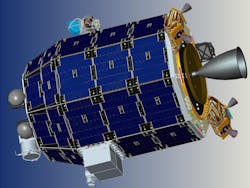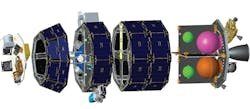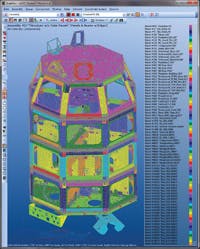Software lets spacecraft carry heavier loads
Researchers at NASA’s Ames Research Center, Moffett Field, Calif., are developing a Common Bus spacecraft made of stackable octagonal rings and off-the-shelf parts to form small landers, orbiters, or rovers. The squat octagons measure 14‑in. tall and 46‑in. across, with matching bolt patterns around their ends for quick assembly. When stacked, they form the craft’s body and serve as a monocoque structure — a shell that supports loads.
To customize the rings’ composite and metal makeups, engineers use HyperSizer structure-optimization software from Collier Research Corp., Newport News, Va. It calculates failure modes and logs data to predict how material choices, construction types, and input loads will affect a design’s ability to withstand its environment. It makes trade-off studies to find permutations that best balance design goals using a material-property database with information from literature and empirical tests.
NASA engineers recently used HyperSizer to design the first Common Bus craft, the Lunar Atmosphere Dust Environment Explorer, or LADEE. It is scheduled to launch this year, orbit the Moon, and analyze lunar dust. Two of LADEE’s four modules contain propulsion systems. The other two carry avionics, communications gear, and experiments. The vehicle is clad in solar panels.
Once the team arrived at a working design, HyperSizer sharpened LADEE’s finite-element model to profile about 500,000 shell elements subject to nearly 100 global loads. For each element, the software checked about 20 failure modes and interactions, including core shear, flatwise tension, face dimpling, and local buckling. HyperSizer also verified metal interfaces and brackets. In all, the software calculated 1 billion structural margins and organized the data into detailed illustrations of critical loads and failure modes.
Before HyperSizer, NASA engineers manually analyzed such data, or hired analysts to write code to do so. Usually, this resulted in complicated designs being simplified. Then analysts applied stresses and strains to critical areas and thickened any resulting overstressed areas, often missing strength-to-weight goals.
Thanks in part to HyperSizer optimization, LADEE’s body is a tailored blend of materials. Most of its panels are lightweight T300 carbon-epoxy composite with a Tencate RS-3C resin. T300’s high specific strength and low thermal distortion ensure the pointing accuracies of observational instruments. The propulsion housing is stiff M55J, a carbon-cyanate fiber composite that prevents vibrations at natural frequencies.
A heat-rejecting radiator relies on an aluminum-faced panel while bonded-aluminum inserts serve as interface sections and are shaped for thermal survivability. Most brackets are sheet metal or machined aluminum. Larger panel-to-panel interface fittings consist of bonded machined titanium. All panels have aluminum honeycomb cores.
Empty, LADEE weighs 102 lb with composite-faced panels accounting for about 70% of the weight, aluminum-faced panels for 5%, and metal inserts, fittings, and brackets making up the final 25%. Instruments add another 184 lb and the spacecraft will carry about 514 lb of fuel, giving the spacecraft an 800‑lb take-off weight.
“In the past, Ames designs have been overweight,” says Ian Fernandez, materials and analysis lead on LADEE. “HyperSizer lets Ames be competitive in lightweight designs where more failure modes and stress interactions are possible and must be checked.” As budgets are trimmed, the software could replace several rounds of physical tests.
About the Author
Elisabeth Eitel
Elisabeth Eitel was a Senior Editor at Machine Design magazine until 2014. She has a B.S. in Mechanical Engineering from Fenn College at Cleveland State University.




